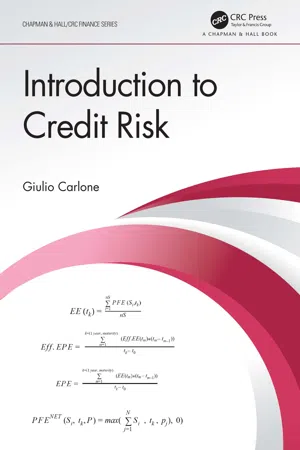
- 360 pages
- English
- ePUB (mobile friendly)
- Available on iOS & Android
Introduction to Credit Risk
About this book
Introduction to Credit Risk focuses on analysis of credit risk, derivatives, equity investments, portfolio management, quantitative methods, and risk management. In terms of application, this book can be used as an important tool to explain how to generate data rows of expected exposure to counterparty credit risk. The book also directs the reader on how to visualize, in real time, the results of this data, generated with a Java tool.
Features
-
- Uses an in-depth case study to illustrate multiple factors in counterparty credit risk exposures
-
- Suitable for quantitative risk managers at banks, as well as students of finance, financial mathematics, and software engineering
-
- Provides the reader with numerous examples and applications
Giulio Carlone has an MBA, a PhD, and a Master's degree in Computer Science from the University of Italy. He is a member of the software system engineering staff of the Department of Computer Science at University College London. He has 20 years of practical experience in technical software engineering and quantitative finance engineering in the commercial sector. His research interests include the use of communication strategies and the implementation of plans and projects using financial software for requirement specifications, requirements analysis, and architectural design.
Frequently asked questions
- Essential is ideal for learners and professionals who enjoy exploring a wide range of subjects. Access the Essential Library with 800,000+ trusted titles and best-sellers across business, personal growth, and the humanities. Includes unlimited reading time and Standard Read Aloud voice.
- Complete: Perfect for advanced learners and researchers needing full, unrestricted access. Unlock 1.4M+ books across hundreds of subjects, including academic and specialized titles. The Complete Plan also includes advanced features like Premium Read Aloud and Research Assistant.
Please note we cannot support devices running on iOS 13 and Android 7 or earlier. Learn more about using the app.
Information
CHAPTER 1
1.1 Financial Risk
- Credit default risk is the risk of an identifiable loss by a bank that believes it probable that a creditor will not fully honour their credit obligations or that they may encounter significant delays in the payment of a substantial obligation.
- Concentration risk is the risk associated with a single or a group of exposures that may cause significant losses that can undermine a bank’s own sustainability. This concentration may be towards a single obligation or an entire sector.
- Country risk is the risk of a loss arising from a state freezing its payments in foreign currency (transfer/conversion risk) or defaulting its payments (sovereign default risk).
1.2 Credit Risk
1.3 Credit Risk Measure
- Concerning expected exposure with regard to the management of risk, institutions are only interested in positions with positive Mark to Market because, as pointed out previously, counterparty risk is asymmetrical, and only these positions can generate exposure. The expected exposure on time frame t is only concerned with positive Mark to Market. It is defined as the arithmetical average of exposure distribution at a set future date.
- Concerning potential future exposure (PFE), we can state that at a set date t and taking the worst possible scenario into consideration, it indicates the value of exposure at a set future date towards a specific level of confidence. As future Mark-to-Market values cannot be known for certain, at a set future date, the PFE can only be described as some form of probability distribution.
- The expected positive exposure at a set date [0; T] is a methodological estimation of future exposure of transactions subject to counterparty risk based on a weighted average contemplated over a time frame defined by the expected values of exposures. This weighted average is defined by the relation between the time frame of each single expected exposure and the entire period of time being considered.
1.4 Monte Carlo
1.5 Interest Rate Swap
Table of contents
- Cover
- Half Title
- Series Page
- Title Page
- Copyright Page
- Table of Contents
- Preface
- Author
- Introduction: Starting with Credit Risk
- Chapter 1 ▪ Background of Credit Risk and Java Visualization for Expected Exposure
- Chapter 2 ▪ Theoretical Phase of a Real-World Case Study
- Chapter 3 ▪ Real-World Case of the Practical Phase for Generating Exposure Regulatory Measures in a Specific Bank with an Internal Model Method
- Chapter 4 ▪ Theoretical Approach of the Real-World Case Phase Related to the Methodology of Scenario Simulation Used for Generating Exposure Regulatory Measures
- Chapter 5 ▪ Generation of a Simulation of a Real-World Case for Generating Exposure Regulatory Measures
- Chapter 6 ▪ Compute Exposure by Counterparty
- Chapter 7 ▪ First Quantitative Analysis of Portfolio Exposure Profiles
- Chapter 8 ▪ Further Analysis on Portfolio Exposure Profiles Using Zero Rate Vector 0.03
- Chapter 9 ▪ Further Analysis of Portfolio Exposure Profiles with Zero Rate Vector 0.06
- Chapter 10 ▪ Generalization of Analysis on Portfolio Exposure Profiles with Zero Rate Vectors 0.01, 0.03, and 0.06
- Chapter 11 ▪ Risk Perspective of Credit Valuation Adjustment
- Chapter 12 ▪ Further Work
- Chapter 13 ▪ MATLAB Source Code Strategy and Analysis for Generation of Time Step Set of Data
- Chapter 14 ▪ Expected Exposure Visualization List of Java Code Packages
- Chapter 15 ▪ Expected Exposure Visualization List of UML Diagram
- Chapter 16 ▪ Credit Models Using Google Cloud
- Chapter 17 ▪ Conclusion
- Index